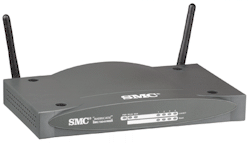Introduction

| SMC7004VWBR 2.4GHz Wireless Cable/DSL Broadband Router | |
|---|---|
| Summary | 802.11b wireless version of new-generation Barricade (SMC7004VBR) |
| Update | None |
| Pros | • Schedulable firewall rules and URL keyword blocking, with different time periods per day • Supports 10 WAN IP addresses • Good throughput vs. distance performance |
| Cons | • No Web traffic logging • No static inbound port range mapping • No wireless monitoring or MAC address Association controls • 30% throughput reduction with WEP enabled |
Given that SMC’s original AMIT based line of Barricade routers were among my favorites, I’ve wanted to like their new AdmTek based Barricade “V” series. But after putting both the non-wireless SMC7004VBR, and now their 802.11b “VWBR” wireless version though their paces, I find myself wondering whether SMC has lost the formula they had in the original Barricades.
The VWBR is essentially a VBR with 802.11b wireless capability added. So hop on over and read that review for all the routing details. If you’ve already been there, just continue on to the wireless section of this review by clicking on the link below.
Wireless Details
The wireless feature set is pretty basic, letting you set just ESSID, transmit rate, and channel (you can also set the wireless base rate, but the User Manual and help were not very instructive with regard to what this setting really does). Security features are limited to enabling 64 or 128 bit WEP, with no MAC address Association control, ability to disable ESSID broadcast, or deny clients using “ANY” or “default” as their ESSIDs. Make sure you write down the WEP keys that you put into the VWBR, too, because it neither stores them in clear text, nor lets you save or load them to/from a file.
Wireless Performance
My wireless performance testing revealed both good and bad news. The good was that, paired with my standard ORiNOCO Gold PC card test client, it performed well under all four test conditions, with throughput staying consistently above 4Mbps. The bad news was that I measured a 30% throughput reduction with WEP enabled, enough to give some users pause in enabling it. (I still recommend running with WEP-enabled unless you want to make your LAN available to anyone who comes into range.)
Routing performance was pretty much in line with that of the non-wireless VBR, with one exception. The VWBR ran the UDP streaming tests in both WAN-LAN and LAN-WAN directions without incident, and with essentially no performance degradation. (The VBR would not complete the LAN-WAN UDP streaming tests.) I hope that means that the VWBR won’t have the DMZ and port-forwarding problems that have been plaguing some owners of the VBR, but I’ll have to wait for user reports to come in before I’ll know for sure.
802.11b Wireless Performance Test Results
| Test Conditions
– WEP encryption: DISABLED |
Firmware/Driver Versions
AP f/w: |
||||
|---|---|---|---|---|---|
| Test Description | SNR (dB) | Transfer Rate (Mbps) | Response Time (msec) | UDP stream | |
| Throughput (kbps) | Lost data (%) | ||||
| Client to AP – Condition 1 | 55 | 4.55 [No WEP] 3.14 [w/ WEP] |
176 (avg) 253 (max) |
494 | 0 |
| Client to AP – Condition 2 | 44 | 4.46 | 179 (avg) 264 (max) |
493 | 0 |
| Client to AP – Condition 3 | 26 | 4.44 | 180 (avg) 321 (max) |
493 | 0 |
| Client to AP – Condition 4 | 25 | 4.45 | 180 (avg) 267 (max) |
493 | 0 |
See details of how we test.
Closing thoughts
It’s not that the VWBR is a bad product, but more that it doesn’t seem to have anything special (except for its ability to handle Internet sharing for up to ten WAN IP addresses) that will spark potential buyers’ interest. Gone is the ability to handle dialup or ISDN WAN connections, and also gone is the built-in parallel port print server. Although these features may not have had wide enough appeal to offset the increased Tech Support load they generated, I sure use them both on a daily basis on the original-series 7008BR that serves as my main router. As a wireless router, the VWBR has good long-range performance to recommend it, but comes up short on security and wireless client monitoring features and the ability to attach external antennas.
On the other hand, SMC’s recent introduction of their TI ACX100-based “Turbo” 22Mbps wireless line does give prospective customers something interesting to consider. But four wireless Barricades in the product line (7004AWBR, 7004WFW, 7004VWBR, 2404WBR) just seems like one (or two) too many. The question is, will the VWBR be the one to get voted off the island?
